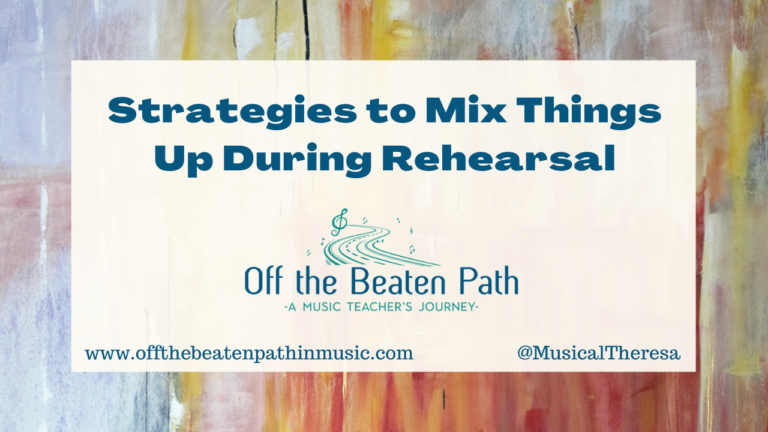Apps for Beginning Band and Orchestra
Updated December 2022
This post has gotten a much-needed update! It’s no secret; I am a fan of technology in education. In my last two teaching positions, all students had school-issued iPads. I enjoyed using the iPads with my band students and have found several apps that work well in this setting. While I would never advocate for using technology exclusively in an instrumental music class (they need to play the instruments, right?) it can be a great supplement. Here are my favorite apps for beginning band and orchestra.

Staff Wars
Staff Wars has been around for several years but it’s still a teacher and student favorite. In Staff Wars, students race to name notes correctly. The more notes they get correct, the faster the game moves! It’s quite fun. A relatively recent addition is Staff Wars Live, which requires students to play the notes shown on the screen. Staff Wars is available in the treble, alto, tenor, and bass clefs along with the grand staff. It is also possible to set the note range for each clef. Warning – Staff Wars can be quite addicting! I have had success using this with group lessons (4-8 students) by projecting it on the board and having students take turns on my iPad. At times, I will also use it as a station, with one or two students playing at a time. The Staff Wars app is available for iOS and Android devices, but Staff Wars Live is currently only available for iOS.


Rhythm Cat
Rhythm Cat is an app I stumbled upon a few years ago when they were doing a free promotion. It reminds me of the video game, “Guitar Hero.” Students must tap (on the iPad) the rhythm as it plays on the screen. Each rhythm gets progressively harder. The background music is cute and the cats are even cuter! I typically use this app during group lessons. I will project the game from my iPad on to the board and students take turns tapping on my iPad. Those who are waiting have to play the rhythm on their instruments, and sometimes I’ll have brass players buzz. To take it one step further, with my string players, I have used this as a


Essential Elements Interactive
Essential Elements Interactive (EEi) is an amazing resource that accompanies the Essential Elements method book for band and strings. I originally made the switch to Essential Elements somewhat because of EEi and an interest in moving to a personalized approach with my band and orchestra students. EEi contains the notation and recordings of every song in the Essential Elements book, plus fingering charts, videos, practice charts, and more. The recordings allow the students to play with multiple accompaniments, such as rock, jazz, classical, etc. It also allows the student to play with a metronome or even slow the tempo! EEi even has recording capabilities, which the students can then submit to the teacher directly from the app.
As a somewhat recent addition, EEi now includes SoundCheck, which will provide students with feedback on their playing. The students seem to enjoy it, especially the varying accompaniments, and it makes a difference when they use it for practice. Struggling students can get support when practicing with EEi and advanced students feel more confident moving ahead in the method book.


Sight Reading Factory
Sight Reading Factory is an app (and website) that makes sight reading practice fun and easy. You begin by choosing your instrument, difficulty level, time signature, and key signature, then Sight Reading Factory generates an excerpt for you to play! There are even options for rhythm-only excerpts and other customizations. Subscriptions are available for educators at a very reasonable cost, and you can also give students full access for only $2 per student. With student accounts, teachers can create assignments, give students feedback, incorporate practice logs, and more. Sight Reading Factory is currently only available as an iOS app, but Android users can access it through the web browser.


GarageBand
GarageBand is a digital audio workstation (DAW) made for Apple devices. It’s a great tool for creating music using loops, virtual (MIDI) instruments, recorded audio, and a variety of editing tools. Beginning instrumental music students can use GarageBand to create their own backing tracks for exercises and songs they are working on, record themselves playing, create their own original music, and more. For more ideas about how to use GarageBand, check out Using a Digital Audio Workstation (DAW) in Band.
Other Apps for Beginning Band and Orchestra
- Flip (formerly Flipgrid) is not a music-specific app, but it’s still one of my favorites. Flip is a video response platform where students can share and view videos of a specific topic. Learn more about using Flip in this blog post: Using Flip in Instrumental Music.
- Padlet is also not music-specific, but another great way to give all students a voice in the classroom. Padlet is a digital bulletin board where users can share text, video, pictures, links, and more.
- Bandmate Tuner – The Bandmate chromatic tuner was developed by a music educator. Not only can you can use it for band and orchestra, but it also displays the note (transposed) on the staff! This is great for music students of all ages.
- The Music Rhythm Trainer – This app helps musicians develop their sense of rhythm, improve rhythm reading skills, and identify rhythmic mistakes by ear.
NinGenius –NinGenius has games to help students learn note names and fingerings on band and orchestra instruments.- The Monster Musician – Learn to sight-read music through games! Using a systematic approach, students learn to first focus on rhythms and get real-time feedback as they progress through the various levels.
- Violin Bow Hand Coach – This app guides users through seven bow hold exercises. Complete with a metronome, timer, and written instructions, it can help students effectively practice this important skill.
- Tonal Energy – The Tonal Energy app is a one-stop-shop for musicians containing a tuner, metronome, tone generator, recorder, and more. Students will especially love the green smiley face that appears and grows as they sustain a pitch in tune.
- Rhythm Swing – Rhythm Swing teaches students about rhythm and rhythmic notation. Students tap along on the screen and receive real-time feedback. Rhythm Swing is available on iOS devices.
- Complete Rhythm Trainer – Another rhythmic focused app to help students read, play, and write rhythms through game-based play.
- Rhythm Sight Reading Trainer – This app is designed to help musicians improve their rhythm sight reading skills. Users can both practice and test themselves on sight reading. Rhythm Sight Reading Trainer is currently available for iOS devices.
- Earpeggio – Earpeggio is an ear training app to help musicians learn to identify intervals, chords, chord progressions, melodies, and rhythms. Earpeggio is currently available for iOS devices.
- Fingerings – The Fingerings app contains detailed fingering charts for brass and woodwind instruments, including trills and alternate fingerings. A must-have for band directors! This app is currently available for iPhones only.
A Couple Last Notes About Apps in the Music Room
Technology will never be a substitute for playing a musical instrument or good pedagogy, but when used appropriately, apps can support and benefit our students. Before using any technology with students, be sure to check any guidelines and restrictions put in place by your school district. These guidelines keep student information private and safe on the internet.
Looking for additional ways to use technology in your music room? Check out these posts:
- Organizing the Paperless Band Room (Part 1)
- Organizing the Paperless Band Room (Part 2)
- Using Student-Created How-To Videos for Skills Assessment
- Using a Digital Audio Workstation in Band
- Music Snippet: Music Notation for Google Docs and Slides
- Creating Music with Groove Pizza
What are your favorite apps for beginning band and orchestra? Are there any I left out? Leave a comment below and I will add your contributions to this




2 Comments